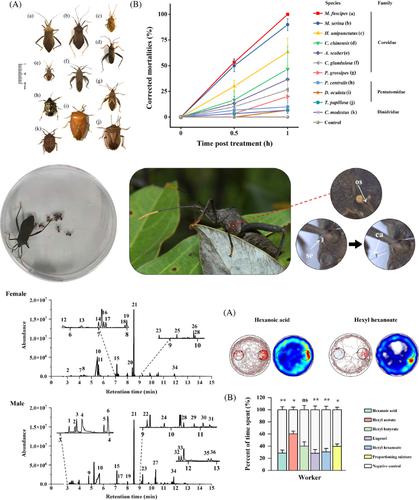当前位置:
X-MOL 学术
›
Pest Manag. Sci.
›
论文详情
Our official English website, www.x-mol.net, welcomes your feedback! (Note: you will need to create a separate account there.)
Bioactivities of scent gland chemicals from Mictis fuscipes Hsiao (Hemiptera: Coreidae) on Solenopsis invicta Buren (Hymenoptera: Formicidae)
Pest Management Science ( IF 4.1 ) Pub Date : 2024-02-27 , DOI: 10.1002/ps.7997 Jiamei Zhong 1, 2 , Eduardo G. P. Fox 3 , Siquan Ling 1 , Zheng Yan 4 , Jinzhu Xu 1 , Hua Yang 1 , Ziqiong Hong 1 , Changsheng Qin 1 , Hualong Qiu 1
Pest Management Science ( IF 4.1 ) Pub Date : 2024-02-27 , DOI: 10.1002/ps.7997 Jiamei Zhong 1, 2 , Eduardo G. P. Fox 3 , Siquan Ling 1 , Zheng Yan 4 , Jinzhu Xu 1 , Hua Yang 1 , Ziqiong Hong 1 , Changsheng Qin 1 , Hualong Qiu 1
Affiliation

|
BACKGROUNDGiven the chemical diversity within stink bugs scent glands, they can be convenient models for bioprospecting novel pest control products. Preliminary behaviour observations indicated that adult Mictis fuscipes stink bugs secrete liquid droplets when defending against Solenopsis invicta fire ants, killing them within minutes. Hence, this study aimed to analyse the chemical composition of the metathoracic scent gland secretions of M. fuscipes adults, as well as assess their biological activities against fire ants.RESULTSBioassaying fire ants against secretions of several local stink bugs confirmed that the defensive secretions of two Mictis species are significantly more lethal, where M. fuscipes was the most lethal. Volatiles chromatography analysis indicated the secretions of female and male M. fuscipes stink bugs contains 20 and 26 components, respectively, chiefly hexanoic acid and hexyl hexanoate. Five compounds were consistently present in the secretion of female adults: hexyl hexanoate, hexanoic acid, hexyl acetate, hexyl butyrate, and eugenol. These yielded a strong electrophysiological antennal (EAD) response from S. invicta workers, female alates and males, where hexyl acetate showed the strongest response. The combination of these five compounds proved strongly repellent to S. invicta . When tested singly, hexanoic acid, hexyl butyrate, hexyl hexanoate, and eugenol were repellent to S. invicta , but hexyl acetate seemed slightly attractive. Additionally, the same mixture of five components exhibited strong contact and fumigant toxicity towards S. invicta workers, eugenol being the strongest.CONCLUSIONDefensive chemicals of M. fuscipes exhibit robust biological activity against S. invicta and could inspire the development of biopesticides. © 2024 Society of Chemical Industry.
中文翻译:

Mictis fuscipes Hsiao(半翅目:Coreidae)气味腺化学物质对红火蚁(Solenopsis invicta Buren)(膜翅目:蚁科)的生物活性
背景鉴于臭虫气味腺内的化学多样性,它们可以成为生物勘探新型害虫防治产品的方便模型。初步行为观察表明,成年人黑腹鼠 臭虫在防御时会分泌液滴红火蚁 火蚁,在几分钟内杀死它们。因此,本研究旨在分析后胸香腺分泌物的化学成分。福斯西普斯 成虫,并评估它们对火蚁的生物活性。结果对火蚁对几种当地臭虫分泌物的生物测定证实,两种火蚁的防御性分泌物密克提斯 物种的致命性明显更高,其中福斯西普斯 是最具杀伤力的。挥发性色谱分析表明雌性和雄性的分泌物福斯西普斯 椿象含有20种和26种成分,主要是己酸和己酸己酯。五种化合物始终存在于雌性成虫的分泌物中:己酸己酯、己酸、乙酸己酯、丁酸己酯和丁香酚。这些产生了强烈的电生理触角(EAD)反应因维克塔 工人、女性有翼人和男性,其中乙酸己酯表现出最强的反应。这五种化合物的组合证明对因维克塔 。单独测试时,己酸、丁酸己酯、己酸己酯和丁子香酚对因维克塔 ,但乙酸己酯似乎有点有吸引力。此外,五种成分的相同混合物对人体表现出强烈的接触和熏蒸毒性。因维克塔 工人中,丁子香酚是最强的。 结论福斯西普斯 表现出强大的生物活性因维克塔 并可以激发生物农药的发展。© 2024 化学工业协会。
更新日期:2024-02-27
中文翻译:

Mictis fuscipes Hsiao(半翅目:Coreidae)气味腺化学物质对红火蚁(Solenopsis invicta Buren)(膜翅目:蚁科)的生物活性
背景鉴于臭虫气味腺内的化学多样性,它们可以成为生物勘探新型害虫防治产品的方便模型。初步行为观察表明,成年人



























 京公网安备 11010802027423号
京公网安备 11010802027423号